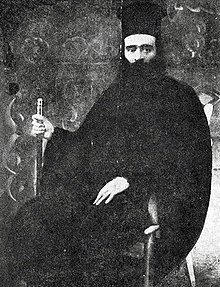Papa Eftim I
Papa Eftim I | |
|---|---|
| Turkish Orthodox Patriarchand Archbishop ofIstanbul | |
 | |
| Church | Turkish Orthodox Church |
| See | Istanbul |
| In office | 1926 – 1962 |
| Predecessor | Prokobiyosas deputy patriarch |
| Successor | Papa Eftim II |
| Orders | |
| Ordination | 1915 |
| Consecration | 1926 |
| Personal details | |
| Born | Pavlos Karahisarithis (Zeki Erenerol) 1883 |
| Died | 14 March 1968 Istanbul,Turkey |
| Nationality | Turkish |
| Denomination | Eastern Orthodox Church |
| Previous post(s) | Deputy Metropolitan ofKeskin(1918-1919) |
Papa Eftim I,bornPavlos Karahisaridis(Greek:Παύλος Καραχισαρίδης;1883 – 14 March 1968),[1]was aKaramanlıTurkish bishop, who was the firstTurkish Orthodox Patriarchof theAutocephalous Turkish Orthodox Patriarchate,anunrecognised Orthodox Christian denominationthat he founded. Eftim I had strong influences fromTurkish nationalistideology. He ruled as Patriarch from 1923 until 1962, when he resigned due to ill health. Keeping the title of honorary patriarch, he ordained his younger son as patriarch assuming the namePapa Eftim II.
Earlier years[edit]
Karahisaridis was born in Madenkaza(todayAkdağmadeni) of Bozoksanjakin 1883. He worked in a factory. He was ordained as a priest in 1915 and was given the name Eftim (Greek:Ευθύμιος). In the house of his neighborÇerkes Ethem,he metMustafa Kemaland became a supporter of his ideas. He took part on 23 April 1920 in the opening of the Turkish Parliament as representative of the Turkish Orthodox Community of All Anatolia (Umum Anadolu Türk Ortodoksları Cemaatleri).[1]
In 1922 theAutocephalous Turkish Orthodox Patriarchate of Anatoliawas founded inKayseriby Father Pavlos Karahisarithis a supporter of theGeneral Congregation of the Anatolian Turkish Orthodox,[2]in opposition to PatriarchMeletius IV.During the meeting in a convent in Kayseri, the decision was made to establish a Turkish Christian church independent of theEcumenical Patriarch of Constantinople.
Papa Eftim clarified his identity as: ''I am not Eftim the friend of Turks, I am Eftim the Turk who is the son of a Turk. I have always clarified my Turkish identity. Foreigners can be friends to Turks. However, a Turkish citizen like me being shown as a foreigner, questioning my people, hurts me deeply. I will never forgive people who do not call me a Turk, but rather a friend of Turks.''[3]
Karahisarithis moved to Istanbul in 1923, and took the name Pope Eftim I. The same year, his supporters, with his tacit support assaulted Patriarch Meletius IV on 1 June 1923.[4]On 2 October 1923 Papa Eftim besieged the Holy Synod and appointed his own Synod. When Eftim invaded the Greek Orthodox Patriarchate he proclaimed himself "the general representative of all the Orthodox communities" (Turkish:Bütün Ortodoks Cemaatleri Vekil Umumisi).
With a new Ecumenical PatriarchGregory VIIelected on 6 December 1923 after the abdication of Meletius IV, there was another occupation by Papa Eftim I and his followers, when he besieged the Patriarchate for the second time. This time around, they were evicted by the Turkish police.[5]
Establishment of the Turkish Orthodox Patriarchate[edit]
In 1924, Karahisarithis started to conduct theliturgyinTurkish,and quickly won support from the newTurkish Republicformed after the fall of theOttoman Empire.[6]He claimed that theEcumenical Patriarchate of Constantinoplewas ethnically-centered and favored the Greek population. Being excommunicated for claiming to be a bishop while still having a wife (married bishops are not allowed in Orthodoxy) Karahisarithis, who later changed his name to Zeki Erenerol, called a Turkish ecclesial congress, which elected him Patriarch in 1924.
On 6 June 1924, in a conference in the Church of the Virgin Mary (Meryem Ana) in Galata, it was decided to transfer the headquarters of the Turkish Orthodox Patriarchate from Kayseri to Istanbul. In the same session it was also decided that the Church of Virgin Mary would become the Center of the new Patriarchate of the Turkish Orthodox Church.
Karahisarithis and his family members were exempted from thepopulation exchangeas per a decision of the Turkish government, although there was not the exemption for either Karahisaridis' followers or the widerKaramanlidescommunities of Turkish speaking Christian that was hoped for.[7]Most of the ethnic Turkish speaking Orthodox population remained affiliated with the GreekEcumenical Patriarchate of Constantinople.
Theexcommunicationof Papa Eftim was revoked and he is consecrated as a bishop bymetropolitan bishopsAmorsios of Kayseri, Kirilios of Erdek and Agatangelos of Adalar on 18 March 1926.
In 1953 he organized a demonstration march against the Greek Orthodox Ecumenical PatriarchAthenagoras Iand he continued to make statements against the Greek Patriarchate.
Resignation and death[edit]
He resigned in 1962 due to ill health and his elder son Turgut Erenerol (formerly Giorgios Karahisaridis) becamePapa Eftim II,and held this post until his death in 1991. The office was then passed to his younger son Selçuk Erenerol, who took the titlePapa Eftim IIIuntil 2002. The current holder of the title is Paşa Ümit Erenerol, Papa Eftim I's grandson (son of Selçuk Erenerol, Papa Eftim III) who has held the titlePapa Eftim IVsince 2002.
He died on 14 March 1968 and was refused a burial in the Greek Orthodox cemetery ofŞişlidue to his excommunication, and the Turkish government had to intervene to secure his burial.[2]
References[edit]
- ^abHurriyet:Türkçe dua eden bir papa(in Turkish)
- ^abDr. Racho Donef — Sydney, Australia. January, 2003. (2004-01-23)."The Political Role of the Turkish Orthodox Patriarchate (so-called)".Atour.com.Retrieved2013-12-24.
{{cite web}}:CS1 maint: multiple names: authors list (link) CS1 maint: numeric names: authors list (link) - ^Çetintaş, Cengiz (2019-11-18).Cumhuriyet'in Kuruluş Yılı 1923: TBMM Tutanakları Yıllığı(in Turkish). Cengiz Çetintaş.ISBN978-605-81170-6-8.
- ^The Ecumenical Patriarchate Under the Turkish Republic: The First Ten Years,by Harry J. Psomiades]
- ^"The Greek Orthodox Patriarchate and the Turkish-Greek Relations, 1923-1940".Archived fromthe originalon 2013-12-25.Retrieved2013-12-24.
- ^Leader of Turkish Nationalist Church DiesArchivedJanuary 7, 2009, at theWayback Machine
- ^Hugo Rifkind (2013-11-03)."The empty spaces where Greeks once were".Entertainment.timesonline.co.uk.Retrieved2013-12-24.
